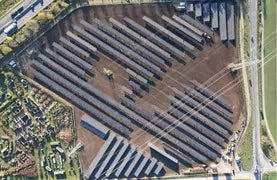https://solarquarter.com/2022/12/03/explained-ultimate-guide-to-cleaning-solar-pv-panels/
Explained: Ultimate Guide To Cleaning Solar PV Panels
Reading Time: 5 minutes
Introduction:
As a source of renewable energy, solar energy is growing in popularity. The power output delivered from a photovoltaic module highly depends on the amount of irradiance, which reaches the solar cells. Over time, PV panels can become dirty and lose their efficiency.
Large-scale utility solar power plants are often installed in areas with the highest solar intensity. These include desert regions. Installations in desert regions can experience high rates of dust deposition which causes dramatic power loss.
Cleaning the modules is essential for solar PV power plants operating in highly dusty conditions. The Solar cells in the module may heat up if they are covered in soil. This can lead to hot spots and safety concerns.
We can expect solar panels to perform at their best and remain free from safety hazards by keeping them clean. This will ensure they provide energy for many years to come.
But it is important to acknowledge the fact that cleaning thousands of solar modules (depending on the plant size) presents a big challenge to operators around the world, especially in areas with high soil deposition rates.
Traditional Cleaning Methods:
There are two types of traditional cleaning methods: mechanical and coating-based.
To remove surface contamination, mechanical cleaning uses gentle cleaners and soft brushes. Dry cleaning that uses ultrasonic vibrations and air-blowing are two other options for mechanical cleaning.
A piezoceramic actuator is another method of cleaning the module. To remove dust from the module, the actuator is installed to wipe the dust from the module using forward and backward wiping actions. The merits of using the piezoelectric actuator in a solar panel cleaning system are that the cleaning system has a lightweight and compact structure, which is a common feature of piezoelectric systems.
In contrast to mechanical cleaning, a coating-based approach involves the deposition of super hydrophilic and super hydrophobic thin films on the surfaces of PV modules. Super-hydrophilic films improve surface wettability, causing water to spread on the surface and collect surface layer dust.
Challenges with Traditional Cleaning Methods:
Cleaning PV panels is labor-intensive and time-consuming. It requires a skilled workforce.
Brushing can also cause micro-scratches to the panels, which can lead to significant PV performance degradation over time.
Water wastage is another problem with traditional methods. It’s a big conundrum, especially in arid areas where many solar farms are located (desert areas) where you have less water and more dust to clean from the panels.
Intelligent Waterless Solar Panel Cleaning Robot
Intelligent Waterless Solar Panel Cleaning Robots have revolutionized solar panel cleaning technology.
It’s an IoT/Cloud-connected smart robot with machine-learning capabilities. It can detect rain and operate if it is not. It detects dust levels and cleans according to them. It distinguishes between dust and bird droppings, or panel damage, and it acts accordingly.
Robots can be modified to fit different panel configurations and are modular in their design. It can be used on Indian rooftops and ground mount farms, regardless of their size or geography.
It is water- and chemical-free thanks to its unique airwash technology. It is self-cleaning and self-powered, ensuring greater efficiency.
This technology ensures quick and reliable cleaning, which in turn results in a Quick Return on Investment. It is also environmentally friendly.
Cleaning Bifacial PV Modules:
Numerous simulations and optimizations were done to determine the impact of soiling rate, albedo, rain, cleaning costs, and strategy in cleaning frequency of the rear sides of a bifacial PV system.
You can clean the bifacial solar PV modules with a soft cloth or brush. This will remove dirt and debris from the surface of the panels without applying too much pressure to the back.
For bifacial module cleaning, it is advisable to have the hydraulic pressure must be below 1500 Pa for the backside of the modules. The frameless bifacial module cleaning process is the same as for conventional PV modules. However, the module without frames requires that you consider the deformation caused due to the applied stress. Use smaller forces to prevent damage or injury to the module.
Another option is to use an automated cleaning system that uses robotics to clean the panels without coming into contact with them.
Conclusion
As time goes by, dirt and dust build-up on the module’s glass surfaces. This can lead to a decrease in output power. It is important to clean the modules regularly.
Solar panels can be cleaned in a variety of ways depending on their size. It is important to also consider regional economics as well as labor costs.
All operations must be performed under the required electrical protection. Follow the manufacturer’s instructions for cleaning solar PV panels.
To know How Do Solar Bifacial + Tracking Systems Work, view below document:






